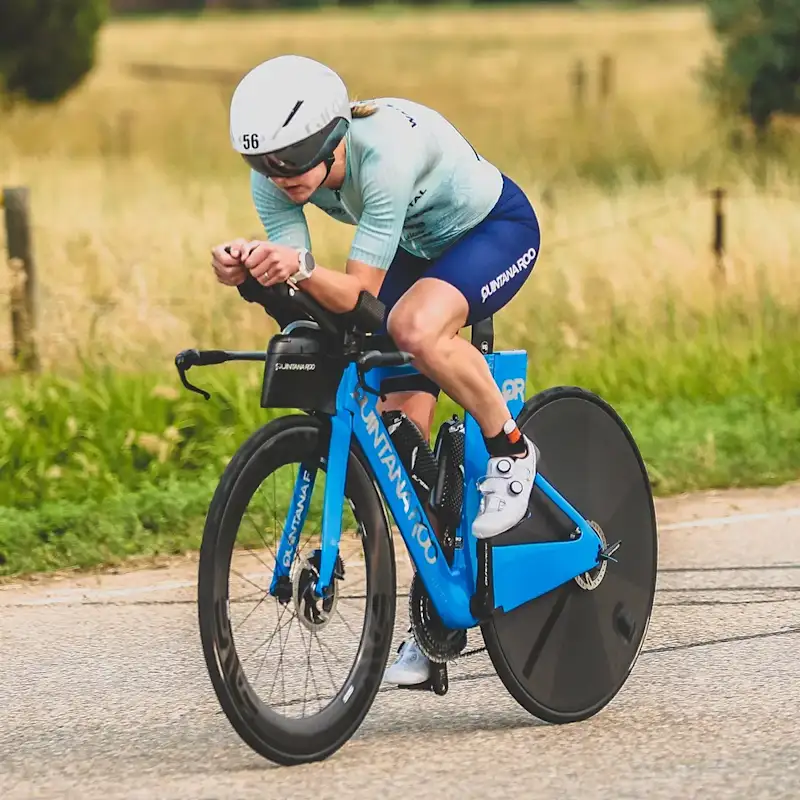
Jeanni Metzler
IRONMAN 70.3® Boulder
Jeanni's headline numbers
Jeanni's strategy
Fueling
Carbohydrate is the main fuel you burn when racing. Failing to fuel properly is a leading cause of underperformance in longer races.
Jeanni’s average carb intake was solid overall and was split into a higher 94g/h on the bike, before dropping off to 54g/h during the run. In long distance triathlons like this, athletes often 'frontload' their carbohydrate intake during the bike leg, as it's typically easier to consume larger amounts of carbs while cycling than it is running. The frontloading of carbohydrates is a popular approach, and also helps reduce the need for heavy carbohydrate intakes during the run, where many athletes are more prone to gastrointestinal issues due to the mechanics of running.
Hydration
Taking on board an appropriate amount of fluid and sodium is essential to maintaining blood volume and supporting the cardiovascular effort needed to perform on race day.
Whilst the absolute amount of sodium and fluid consumed per hour is important, it’s critical to consider these in relation to each other. This is known as 'relative sodium concentration' and it’s expressed in milligrams per litre (mg/L). How much sodium you’re taking in per litre of fluid is more important than the absolute amount taken in per hour.
Sweat sodium concentration (mg/L) is largely genetically determined and remains relatively stable. Knowing how salty your sweat is enables you to replace a good proportion of your sweat losses, which can range from 200-2,000mg/L.
Given Jeanni’s losses are Very High (1,556mg/L), nailing her hydration strategy becomes especially crucial when it’s hot and/or humid.
Learn moreConsidering the heat, Jeanni’s fluid intake was on the lower side for what was necessary to support her sweat losses. In these conditions, increasing her overall fluid intake could be beneficial, especially on the run, as it would help support the absorption of carbohydrates (which in turn may prevent the loss of appetite she experienced). A combination of Jeanni’s high sodium intake and lower than ideal fluid intake meant that the relative sodium concentration of the fluids she consumed were higher than the sodium concentration of her sweat. This would’ve likely played a part in the feeling of thirst she experienced at the end of the bike leg. So, we would recommend that Jeanni increases her fluid intake in these hotter conditions and slightly decreases the sodium concentration of her bottles in future. This will help dilute the strong relative sodium concentration of her drinks and ensure that they more closely match her above average sweat losses.
Caffeine
Beyond the Three Levers of Performance (carb, sodium and fluid), caffeine is one of only a few substances that is proven to improve performance for most endurance athletes as it can help stave off mental and physical fatigue.
Jeanni consumed a quantity of caffeine which she is accustomed to using during races, and having most of this intake on the bike worked well for her.
How Jeanni hit her numbers
Here's everything that Jeanni ate and drank on the day...
Jeanni's weapons of choice
Final thoughts
Jeanni's full stats
Data Confidence?
There is good confidence in the accuracy of the data reported. An athlete feels that the numbers closely reflect what they consumed despite a couple of estimations which may carry some degree of error. The majority of what was consumed is recorded to a high level of specificity (most volumes are known through the use of bottles brands quantities flavours). The numbers are very plausible and align with previous data recordings (if an athlete has collected data previously).